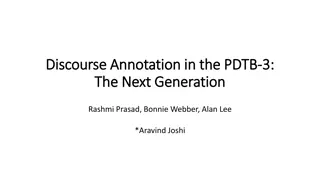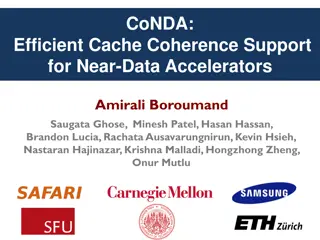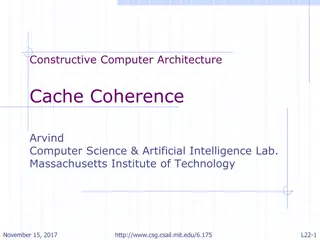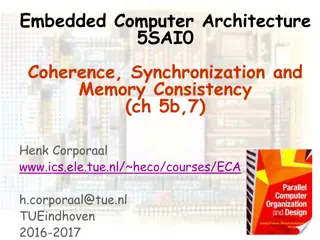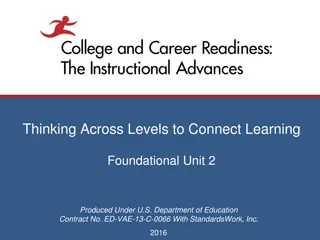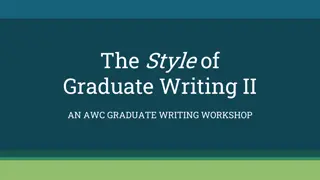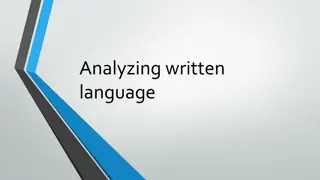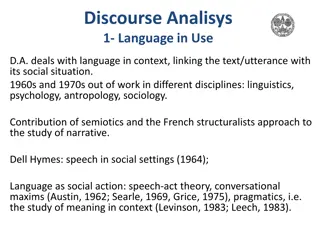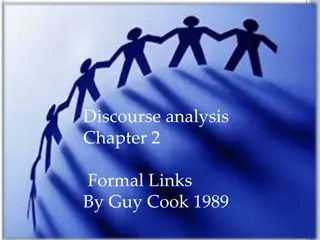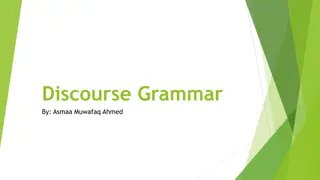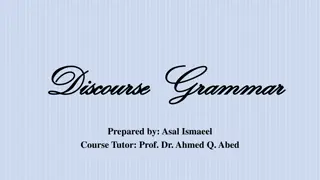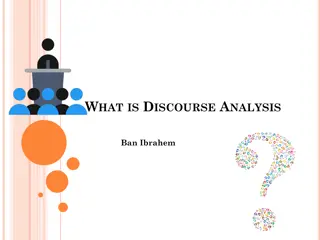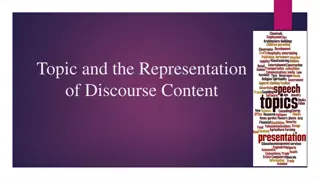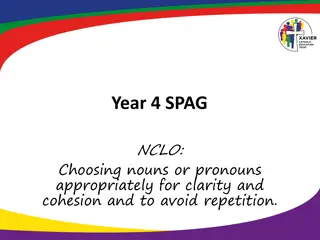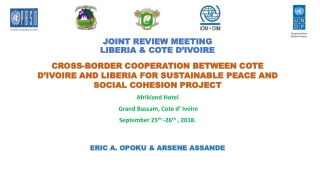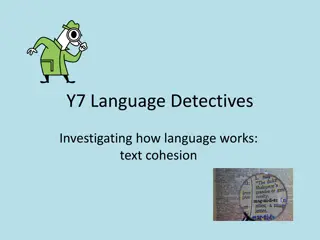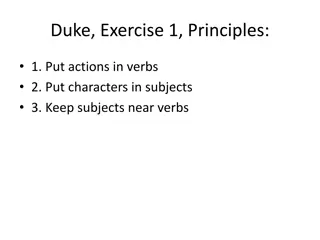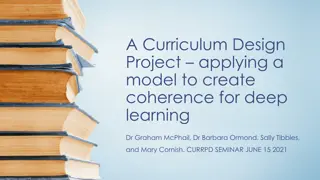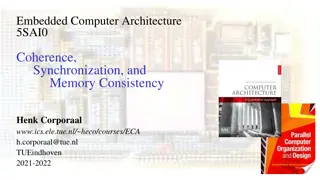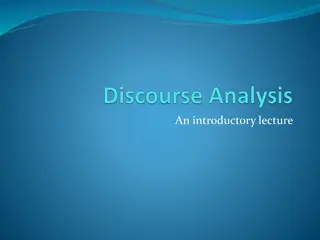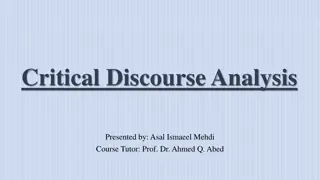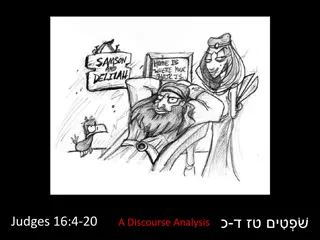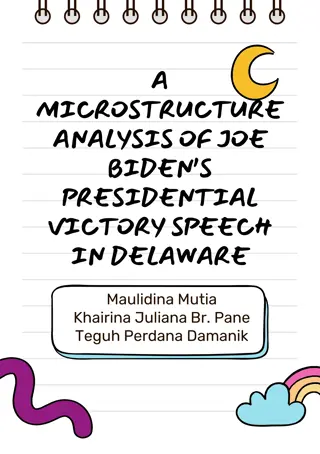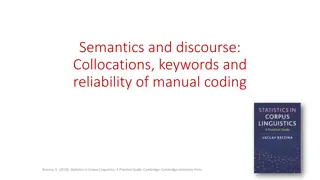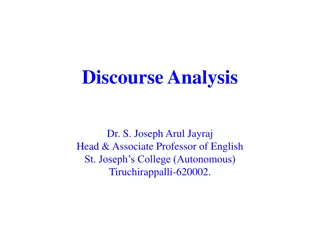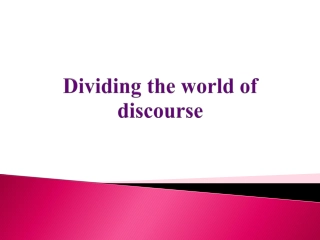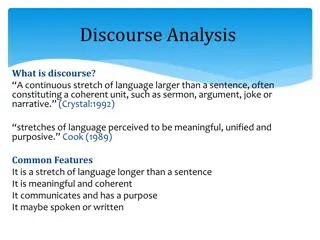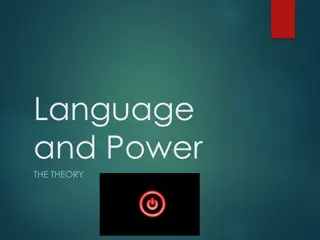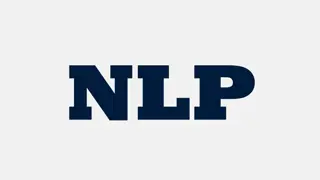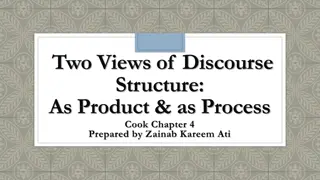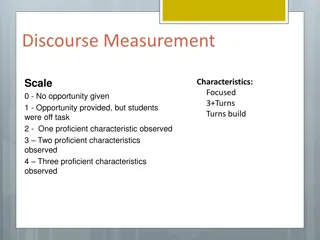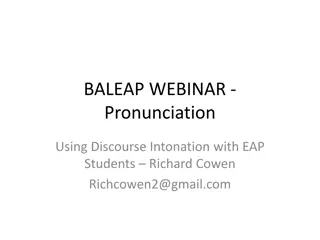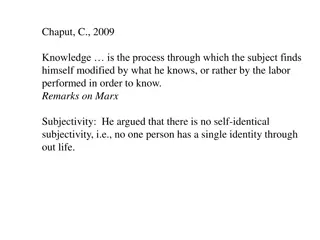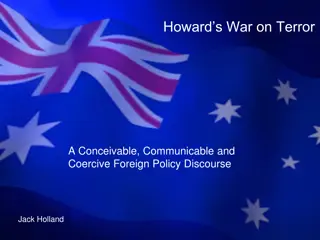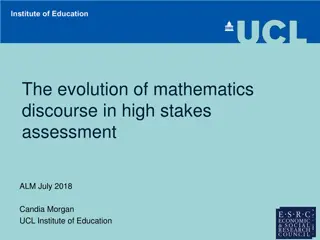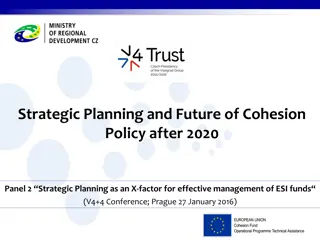Understanding Discourse Analysis: Cohesion, Coherence, and More
Discourse analysis delves into written and spoken communications across various contexts. It encompasses cohesion, which includes grammatical and lexical links within text for creating meaning, and coherence, which ensures semantic meaningfulness. Explore how DA identifies and analyzes language use and events to uncover deeper insights.
Download Presentation

Please find below an Image/Link to download the presentation.
The content on the website is provided AS IS for your information and personal use only. It may not be sold, licensed, or shared on other websites without obtaining consent from the author. Download presentation by click this link. If you encounter any issues during the download, it is possible that the publisher has removed the file from their server.
E N D
Presentation Transcript
It is the term that describes written and spoken communications ; a generalization of the concept of conversation within all modalities and contexts.
Discourse analysis (DA) is a general term for a number of approaches to analyzing written, vocal, or sign language use or any significant event
My Town My natal town was in a small town , very close to Riyadh capital of Saudi Arabia. The distant between my town and Riyadh 7 miles exactly. The name of this Almasani that means in English Factories.
Cohesion It is the grammatical and lexical links within a text or sentence that hold a text together and give it meaning. It is related to the broader concept of coherence.
A cohesive text is created in many different ways. There are five general categories of cohesive devices that create coherence in texts: reference, ellipsis, substitution, lexical cohesion and conjunction.
Reference: "The taxi driver" with the pronoun "he" or "two girls" with "they Here he comes, our award-winning host... It's John Harry!"
Ellipsis (A) where are you going? (B) to town .
Substitution "which ice-cream would you like?" "I would like the pink one" where "one" is used instead of repeating ice- cream."
Coherence It is what makes a text semantically meaningful. It has much to do with the general world knowledge.
Coherence literally means sticking together. When applied to writing, it refers to how well the writing sticks together, how well it flows from one idea to the next. Writing that is coherent is easy to read; each idea flows logically into the next one.
Paragraph 1: I have several good reasons for not going to work today. I was stung several times in the foot by bees while I was walking in my yard last night. I cannot get my shoe on. My son is staying home from school. He has a bad cold. The computer is being repaired at work. I won t be able to get much done anyway.
Paragraph 2: I have several good reasons for not going to work. First, I was stung several times in the foot by bees while I was walking in my yard last night. As a result, I cannot get my shoe on. Secondly, my son is staying home from school because he has a bad cold. Finally, the computer is being repaired at work, so I won t be able to get much done anyhow.
Below is a list of some common transition words and the proper contexts to use them in: - To give examples: for example, specifically, for instance, thus, to illustrate, namely - To give additional information: also, further, in addition, moreover, and - To show how things are related in space: above, below, here, there, opposite - To show how things are related in time: after, before, meanwhile, in the past, later
- To show contrast: but, however, in contrast, on the other hand, even so - To show comparison: similarly, also, in the same way, likewise, in the same manner - To show results: thus, therefore, as a result, consequently, to this end - To show summary: in summary, hence, in conclusion, finally, all in all -
Speech events 1. conversation 2. debate 3. interview 4. discussion
There are three criteria in any speech event: 1. The roles of the speaker-hearer and relationships , 2. The topic of conversation, 3. The setting or context .
Conversation Analysis A conversation is an activity where participants take turns at speaking . Participants wait until one speaker indicates that he has finished by signaling a completion point .
Strategies of participation in conversation - Rudeness , - Shyness , - Holding the floor ( no pauses , use connectors , use hesitation markers,
The Co-operative Principle Make your conversational contribution such as is required , at the stage which it occurs , by the accepted purpose or direction of the talk exchange. - Quantity - Quality - Relation - Manner
Hedges Words or phrases used to indicate that we are not sure what we are saying is sufficiently correct or complete.
A hedge is a mitigating word or sound used to lessen the impact of an utterance. Typically, they are adjectives or adverbs, but can also consist of clauses. It could be regarded as a form of euphemism.
- The party was somewhat return of the parents. somewhat spoiled by the - I' I'm not an expert m not an expert but you might want to try restarting your computer.
- All I know All I know is smoking is harmful to your health. - They told me They told me that they are married. - Compare : 1. Tom is guilty. 2. I may be mistaken , but I thought that Tom is guilty.
Implicature It is an additional meaning not expressed literally. Carol : Are you coming to the party tonight ? Lara : I ve got an exam tomorrow.
Background Knowledge People tend to fill gaps in a discourse People tend to fill gaps in a discourse depending on their experience . depending on their experience . They try to interpret what is said or written according to interpret what is said or written according to real world knowledge. real world knowledge. They try to
Schemas A conventional knowledge structure that exists in memory. Our understanding of what we read is not only based on what we see on the page , but also on other things that we have in mind .



